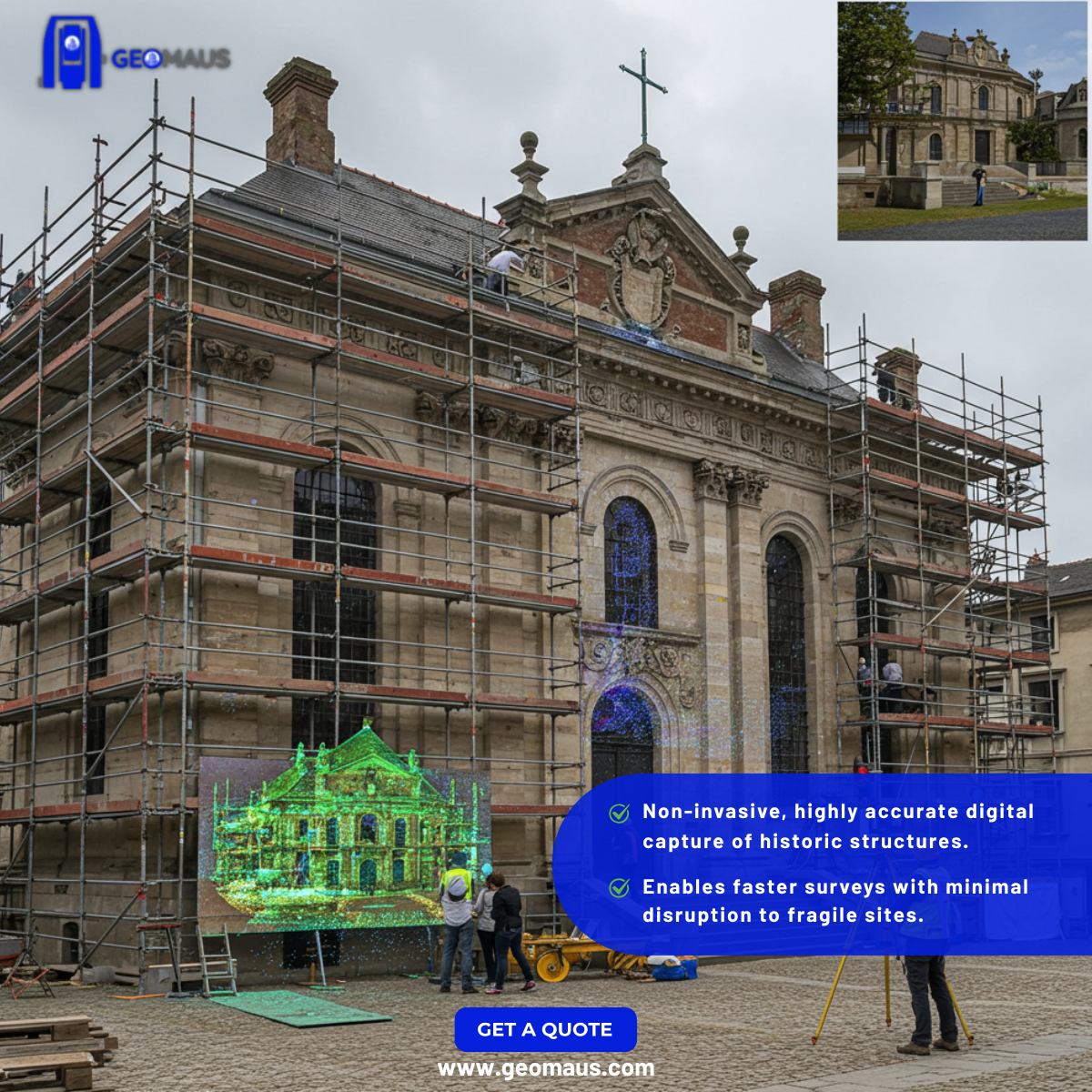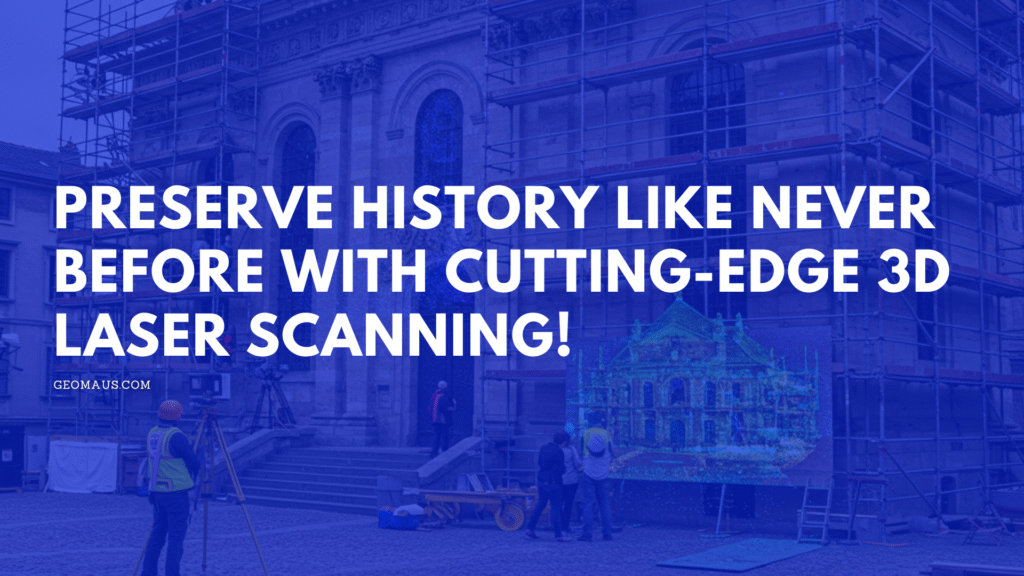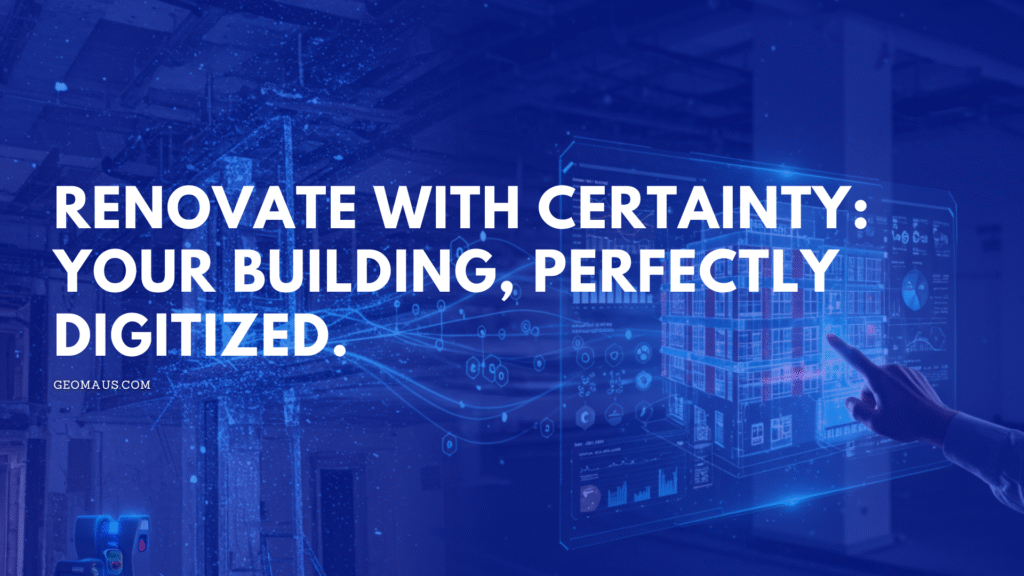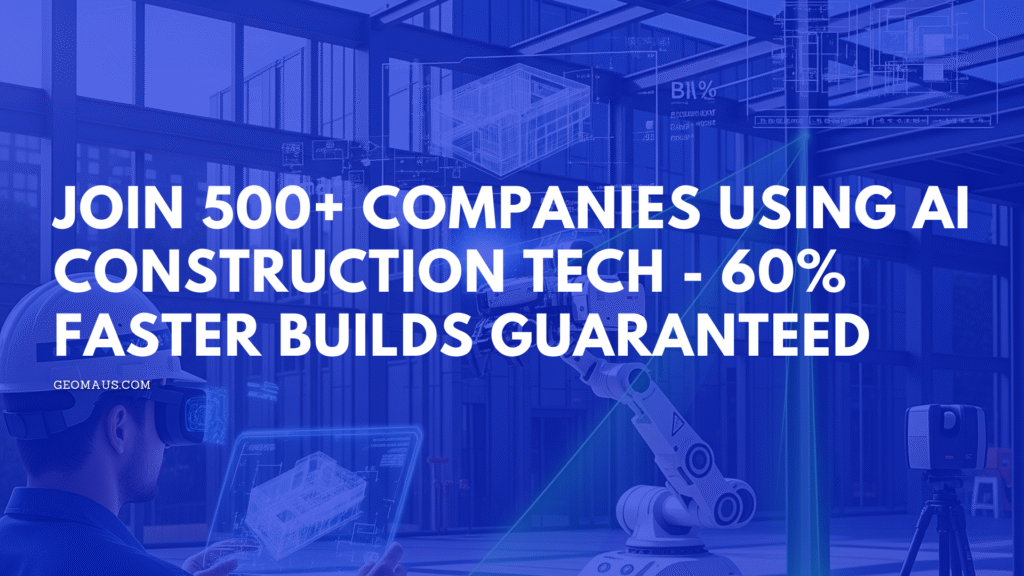Introduction
In an era where our architectural heritage faces unprecedented threats from time, climate change, and urban development, the preservation of historic structures has never been more critical. Traditional documentation methods often fall short in capturing the intricate details that make heritage buildings unique and culturally significant. This is where cutting-edge 3D laser scanning heritage building documentation steps in, revolutionizing how we document, preserve, and restore our architectural heritage.
At GeoMaus, we’re at the forefront of this technological revolution, providing state-of-the-art 3D laser scanning services that transform how heritage buildings are documented and preserved for future generations. Our advanced scanning solutions create precise digital records that serve as invaluable resources for conservation professionals, historians, architects, and property owners alike.
The Critical Need for Advanced Heritage Documentation

Heritage buildings represent irreplaceable cultural assets that tell the story of our collective past. Yet traditional documentation methods—manual measurements, hand drawings, and photography—often prove inadequate for several reasons:
- Time-consuming: Weeks or months to complete what 3D scanning can accomplish in days.
- Lack of precision: Error margins can compromise historical integrity.
- Inability to capture complex geometries: Misses the subtle imperfections and unique character of historic structures.
- Limited data for analysis: Makes it difficult to assess structural conditions comprehensively.
With approximately 39% of global carbon emissions originating from the built environment, there’s increasing pressure on the construction sector to preserve rather than replace existing structures—making accurate documentation essential for sustainable heritage management.
How 3D Laser Scanning Transforms Heritage Preservation
Non-Invasive Documentation with Unparalleled Precision
3D laser scanning technology allows for comprehensive data collection without physical contact with delicate historic structures. This non-destructive approach is particularly crucial when dealing with fragile heritage assets that might be damaged by traditional measuring techniques.
Our scanning technology at GeoMaus captures millions of data points with accuracy up to millimeters, creating a precise digital representation that preserves every architectural detail, from ornate moldings to subtle structural deformations. This level of detail is simply unattainable through conventional documentation methods.
Creating Comprehensive Digital Twins
The point clouds generated through 3D laser scanning serve as the foundation for creating detailed Building Information Models (BIM) of heritage structures. These “digital twins” offer several advantages:
- Provide a complete and accurate record of the building’s current condition.
- Enable virtual analysis and planning without risking the physical structure.
- Facilitate collaboration among diverse stakeholders, from conservationists to engineers.
- Support the integration of historical data with current structural information, creating a comprehensive understanding of the building’s evolution over time.
At GeoMaus, we transform raw scan data into intelligent 3D models that can be accessed through our user-friendly portal from anywhere in the world, enabling unlimited stakeholders to collaborate effectively on preservation projects.
Accelerating Restoration and Conservation Effort
When disaster strikes historic structures, as with the devastating fire at Notre Dame Cathedral in Paris, 3D scanning data becomes invaluable. The detailed scans created by art historian Andrew Tallon proved crucial in the cathedral’s restoration efforts, providing measurements accurate to within five millimeters and collecting over a billion points of data that guided reconstruction of the collapsed spire and damaged sections.
Our scanning services at GeoMaus similarly provide:
- Precise measurements for fabricating replacement elements that match original components exactly.
- Detailed structural analysis to identify hidden weaknesses before they lead to failure.
- Comprehensive documentation that guides restoration teams through complex projects.
- A permanent digital record that preserves the building’s form even if physical damage occurs
The GeoMaus Advantage for Heritage Documentation
Comprehensive Scanning and Modeling Workflow
Our heritage documentation process at GeoMaus follows a proven workflow designed to capture every detail while minimizing disruption to historic sites:
- Initial Assessment: We evaluate the heritage structure to determine the optimal scanning approach based on the building’s significance, complexity, and conservation needs.
- High-Precision 3D Scanning: Using state-of-the-art laser scanning technology, we capture millions of data points to create a comprehensive point cloud of the entire structure.
- Point Cloud Processing: Our experts process the raw scan data, filtering and optimizing it to create a clean, accurate 3D representation.
- BIM Model Development: We transform the point cloud into an intelligent Building Information Model that preserves both geometric data and associated historical information.
- Deliverable Creation: Based on client needs, we produce a range of outputs including detailed CAD drawings, 3D models, virtual tours, and comprehensive documentation packages.
Real-World Applications and Benefits
Our 3D scanning services provide tangible benefits for various heritage preservation scenarios:
Detailed Documentation for Restoration Projects
When historic buildings require restoration, our precise 3D scans provide the exact measurements needed to recreate damaged elements with perfect fidelity to the original. This ensures that restoration work maintains historical accuracy while meeting modern safety standards.
Condition Assessment and Monitoring
Our scanning technology can detect subtle changes in building geometry that might indicate structural issues before they become visible to the naked eye. By comparing scans taken at different times, conservationists can monitor a building’s condition and address problems proactively.
Virtual Access and Education
The digital models we create allow for virtual exploration of heritage sites, making them accessible to researchers, students, and the public without risking damage from physical visitation. This democratization of access enhances educational opportunities and fosters broader appreciation of cultural heritage.
Disaster Recovery Planning
In the event of damage from fire, flooding, or other disasters, our detailed 3D documentation provides the blueprint for accurate reconstruction. This disaster preparedness approach has proven invaluable for heritage sites worldwide.
The ROI of 3D Scanning for Heritage Preservation
Investing in 3D laser scanning for heritage documentation delivers significant return on investment through:
Time and Cost Efficiency
Research shows that 3D scanning can reduce documentation time by 70-80% compared to traditional methods, dramatically accelerating preservation projects while reducing labor costs. This efficiency translates directly to cost savings for project stakeholders.
Enhanced Accuracy and Reduced Errors
The millimeter-level precision of our scanning technology minimizes errors in documentation, preventing costly mistakes during restoration work. This accuracy ensures that conservation efforts maintain historical authenticity while optimizing resource allocation.
Comprehensive Data for Informed Decision-Making
The rich dataset provided by 3D scanning enables more informed conservation decisions, optimizing preservation strategies and reducing unnecessary interventions. This data-driven approach maximizes the effectiveness of preservation budgets.
Long-Term Value Through Digital Preservation
Beyond immediate project needs, the digital models we create serve as permanent records of heritage structures, providing value for decades to come as reference materials for future conservation efforts. This long-term documentation strategy safeguards cultural heritage against loss from deterioration, disaster, or development.
Take the First Step in Preserving Architectural Heritage
The documentation of heritage buildings is not merely a technical exercise—it’s a crucial step in preserving our collective cultural memory for future generations. With GeoMaus’s advanced 3D laser scanning services, you can ensure that the historic structures under your care are documented with unparalleled precision and comprehensiveness.
Our team of experts is ready to help you develop a customized documentation strategy that meets the unique needs of your heritage preservation project. From initial scanning to final deliverables, we provide end-to-end solutions that transform how you approach conservation and restoration.
Are you ready to stop battling outdated as-builts and start leveraging the power of precise digital data?
With Geomaus, you can transform your facility management, saving valuable time, reducing operational costs, and making more informed decisions. Say goodbye to the frustrations of inaccurate plans and hello to a new era of efficiency.
Contact GeoMaus Today
Don’t leave the preservation of irreplaceable heritage to outdated documentation methods. Experience the GeoMaus difference with our state-of-the-art 3D laser scanning services.
- Email: mkiernan@geomaus.com
- Phone: +353833600320
- Website: https://geomaus.com/light
Our team is ready to discuss your heritage documentation needs and demonstrate how our technology can transform your preservation efforts. Contact us today to schedule a consultation and take the first step toward comprehensive digital documentation of your heritage building.
Preserve the past with precision. Choose GeoMaus for heritage building documentation that meets the challenges of tomorrow.



